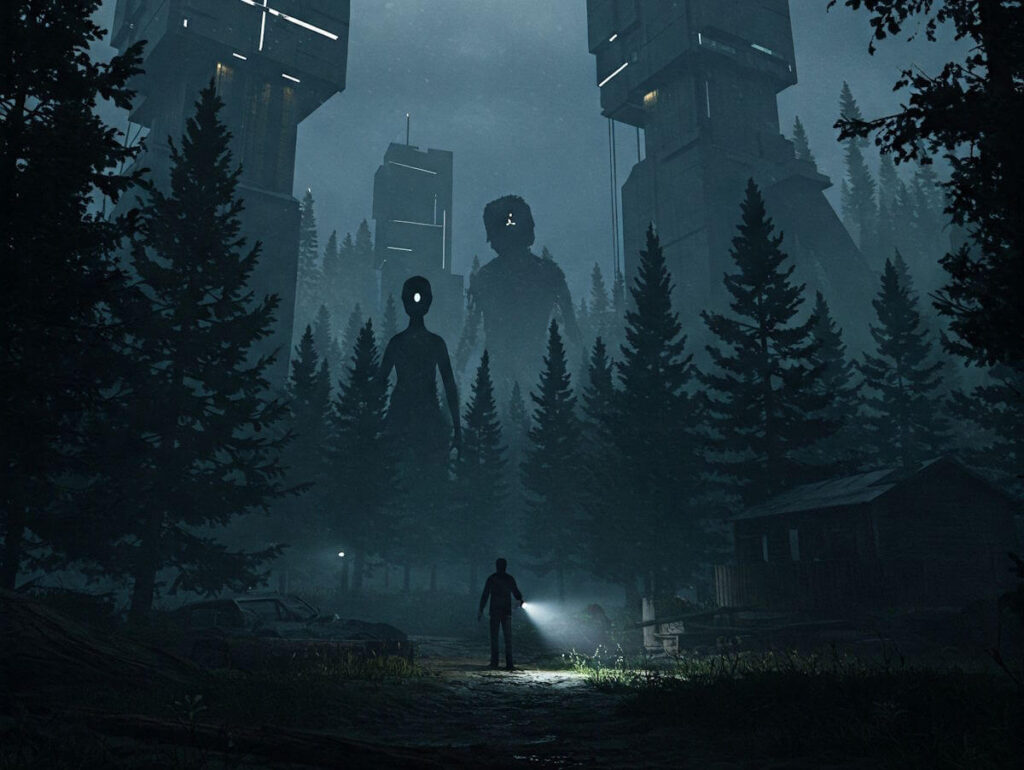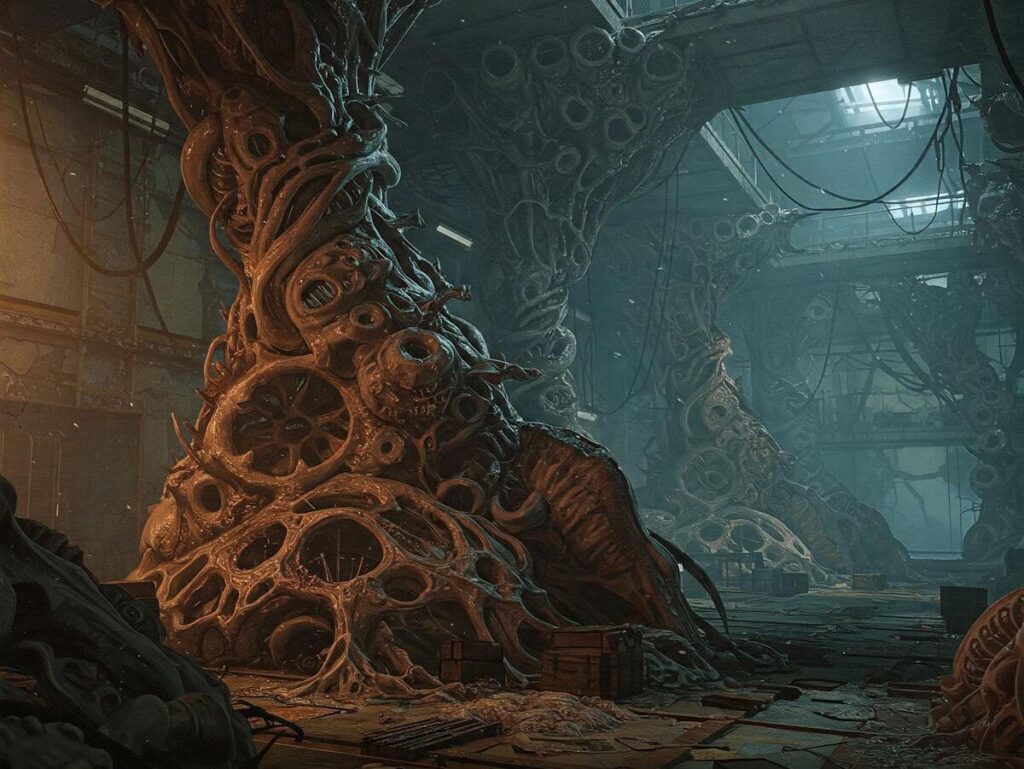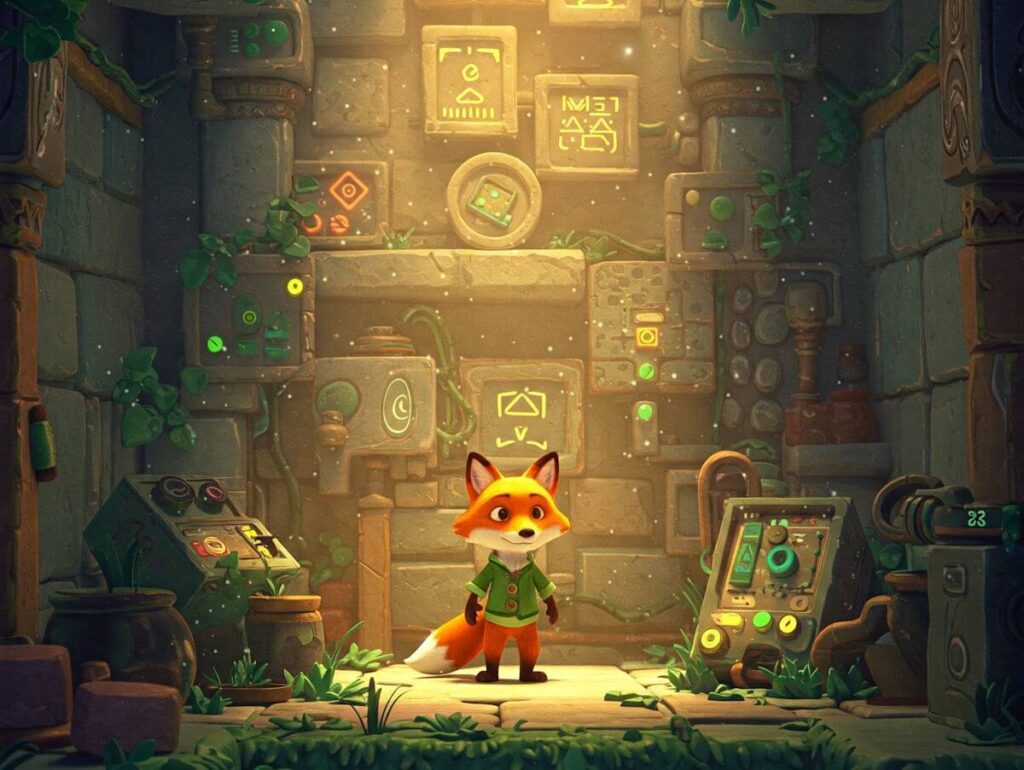Introduction to the Universes of Control and Alan Wake
The worlds of Control and Alan Wake are intricately woven together, offering players a captivating blend of narrative depth and thematic richness. Both games originate from Remedy Entertainment, known for its unique storytelling and innovative gameplay mechanics. This section delves into the core elements of each title, establishing a foundation for examining their shared universe.
Control invites players into the enigmatic Federal Bureau of Control (FBC), a secret government agency tasked with investigating and containing paranormal phenomena. As the main protagonist, Jesse Faden, navigates this surreal world filled with various supernatural occurrences, players encounter a gameplay style characterized by its fluid movement and intense psychic abilities. The central narrative revolves around Jesse’s quest to uncover her past and confront the sinister presence known as the Hiss, which has seized control of the FBC’s headquarters, the Oldest House.
In contrast, Alan Wake centers on the titular character, a bestselling author struggling with writer’s block. Set in the mysterious town of Bright Falls, the narrative unfolds as Alan discovers that the events of his latest manuscript are coming to life, with dire consequences. The gameplay is notable for its focus on environmental storytelling and light mechanics, where players use light as a weapon against dark supernatural entities. Themes of horror, psychological tension, and the complexities of creativity are prevalent throughout Alan’s journey.
Both games explore motifs of identity, reality, and the supernatural, creating a thematic thread that binds them together. By examining their narratives, gameplay styles, and underlying themes, we begin to unveil the intricate connections that suggest Control and Alan Wake share a larger, interconnected universe. This exploration opens avenues for deeper analysis, shedding light on how both titles expand upon and enhance each other’s stories within this unique framework.
The Developers Behind the Worlds: Remedy Entertainment
Remedy Entertainment, a Finnish video game developer, has carved out a significant niche within the gaming industry, particularly renowned for its ambitious approach to storytelling and innovative game design. Founded in 1995, the studio quickly gained acclaim with its first title, Max Payne, which set the stage for a unique narrative-driven experience characterized by its cinematic presentation and engaging storytelling techniques. This foundational experience laid the groundwork for future titles, including Alan Wake and Control, both of which exhibit the studio’s hallmark blend of compelling narratives and intricate world-building.
At the core of Remedy’s philosophy is an unwavering commitment to crafting immersive experiences that resonate with players on a personal level. The studio’s developers are known for their dedication to deep character development and thematic complexity, elements that have become synonymous with the Remedy brand. In both Alan Wake and Control, players are invited to explore environments rich in lore and nuance, encouraging them to engage with the narrative beyond mere gameplay mechanics. Such meticulous attention to detail not only enhances the storytelling but also cultivates a sense of continuity, framing both titles within a cohesive universe.
Moreover, Remedy’s distinctive approach to game design is manifested in its seamless integration of mechanics with narrative elements. For instance, the psychological horror of Alan Wake is intricately intertwined with gameplay elements that propel the story forward, while Control utilizes an array of supernatural abilities that further enrich the player’s immersion in the narrative. This synergy between gameplay and storytelling plays a vital role in legitimizing the interconnected world of both games, ultimately paving the way for a potential narrative crossover that fans eagerly anticipate.
Key Themes and Motifs Shared by Both Games
Both ‘Control’ and ‘Alan Wake’ delve into profound themes that intertwine the psychological and supernatural, crafting a unique narrative experience in their respective universes. One of the most prominent themes in both titles is psychological horror. In ‘Alan Wake’, the protagonist grapples with his struggle against darkness, symbolizing mental anguish and the ephemeral nature of sanity. The narrative intricately explores the boundaries of one’s mind, revealing how fear can warp reality and perception. Similarly, ‘Control’ presents a world where psychological horror permeates, showcasing the Federal Bureau of Control’s (FBC) investigation into unexplained phenomena, inviting players to confront the unknown’s unsettling aspects.
Another salient theme is the frailty and subjective nature of reality. In ‘Alan Wake’, the protagonist’s journey unfolds within a fictional narrative that tends to blur the lines between fiction and reality, provoking questions about authorship and agency. This theme resonates with ‘Control’, wherein the Oldest House serves as a chaotic and ever-shifting environment, reflecting the malleability of perception and existence. The interplay between the characters’ mental states and their surroundings emphasizes that reality may not be as fixed as it appears, further enriching the gaming experience.
The concept of supernatural forces is integral to both narratives. In ‘Control’, these forces manifest through various paranormal phenomena, challenging the characters’ understanding of science and the natural world. ‘Alan Wake’ similarly acknowledges supernatural elements through the Dark Presence, which influences not only the plot but also the characters’ actions and motivations. Collectively, these themes create a cohesive tapestry, illustrating how the two games share a nuanced exploration of psychological complexity alongside supernatural intrigue. This convergence enhances their narratives, inviting players to engage with shared motifs that resonate across both titles.
Connections Through Characters and Lore
The intricate web of character connections between Control and Alan Wake offers players a deeper understanding of the shared universe theory. At the forefront is Alan Wake, a revered writer whose narrative influences extend beyond his own story. Within Control, players encounter a variety of characters who are echoing the themes introduced in Alan’s life. One particularly significant figure is Jesse Faden, the game’s protagonist, who exhibits a complex relationship with the supernatural elements akin to those observed in Wake’s tortured existence.
Furthermore, the association between Alan Wake and Mayor Zachariah Trench presents another layer of connectivity. Trench, the former director of the Federal Bureau of Control, shares a strong thematic resonance with Alan, as both struggle against the forces of an oppressive narrative. The lore surrounding these characters reveals deeper connections; Trench’s investigative endeavors parallel Alan’s own grappling with otherworldly phenomena, suggesting that their paths are intertwined within the larger narrative fabric.
The use of lore in both games signifies the authorship of reality itself, a theme prominently explored through both setting and character. While Wake’s life is steeped in the realm of horror and psychological thriller, Jesse Faden’s journey is grounded in the exploration of governmental control over supernatural occurrences. This thematic duality creates an enriched narrative experience that challenges players to reconsider the boundaries of reality.
Another vital character from Control, Dr. Emil Hartman, further exemplifies this connection. Dr. Hartman’s obsession with Alan provides not only a direct tie yet also emphasizes the impact of one character’s story on another. His attempts to manipulate narratives, paralleled by Wake’s battles with his own crafted tales, showcase a converging point between their experiences. Through these interwoven characters, the overlapping lore establishes a shared universe that beckons for further exploration.
The Role of the Federal Bureau of Control
The Federal Bureau of Control (FBC) serves as a pivotal organization within both the game “Control” and the narrative of “Alan Wake.” As a government agency tasked with investigating paranormal phenomena, the FBC exemplifies the intersection of bureaucratic authority and supernatural occurrences. Established to manage and contain anomalies, the FBC conducts thorough investigations into events that defy the laws of nature, reflecting a comprehensive approach to anomalous research that is central to both narratives.
Within “Control,” the FBC operates out of the mysterious Federal Bureau of Control headquarters, located in New York City. This location is more than just an office; it serves as the epicenter for investigating encounters with the supernatural. Much of the gameplay involves players navigating this ever-shifting environment, where they uncover various documents and artifacts that shed light on the Bureau’s history and operations. The FBC’s extensive archives detail numerous incidents of paranormal activity, many of which resonate with the events experienced by Alan Wake, suggesting a shared narrative thread. This not only establishes the Bureau as an investigative entity but also serves to cement its significance in the broader universe.
Furthermore, the FBC’s operations sometimes brush against the reality presented in “Alan Wake.” The Bureau’s initiatives to document and control supernatural phenomena hint at a larger structure that is capable of understanding and managing the forces that affect its agents and the wider public. As players delve deeper into the FBC’s lore, they may encounter situations or entities reminiscent of those encountered in Alan Wake’s journey, such as characters dealing with altered realities and narratives. This intriguing connection invites players to explore the interplay between these two worlds, enhancing the mystique surrounding the FBC and its overarching role in the game universe.
The Darkness and Its Influence
The concept of ‘The Darkness’ in the game ‘Alan Wake’ serves as a fundamental element that shapes not only the narrative of the game but also introduces psychological and supernatural dimensions that resonate with the themes found in ‘Control’. In ‘Alan Wake’, ‘The Darkness’ is portrayed as a malevolent force that feeds on human fears and insecurities, manifesting itself in various ways to challenge the protagonist. This force alludes to much deeper existential dilemmas, raising questions about identity, trauma, and the human psyche.
In ‘Control’, players are introduced to the Federal Bureau of Control (FBC), an agency that investigates and manages supernatural phenomena. One can theorize that ‘The Darkness’ from ‘Alan Wake’ has a presence in the world of ‘Control’, subtly influencing the strange occurrences and manifestations within the game’s narrative. The ability of ‘The Darkness’ to warp reality could be viewed as a similar phenomenon to the shifting environments within the Oldest House, the game’s central location, which is deeply affected by the paranormal energies at play.
Moreover, ‘The Darkness’ invokes a multitude of entities that embody various forms of fear, suggesting that these concepts might overlap with the numerous supernatural entities encountered in ‘Control’. The Hiss, for example, behaves like a corruptive influence, taking control of individuals and distorting their realities—a hallmark of the manipulative nature attributed to ‘The Darkness’. This potential interrelation raises fascinating narrative implications, as it allows for a discourse on how trauma and fear manifest across different forms and dimensions within the shared universe.
Ultimately, examining ‘The Darkness’ through the lens of ‘Control’ provides an intriguing glimpse into the interconnected nature of these gaming narratives. This intersection invites fans to explore deeper themes while acknowledging the unique manifestations of fear and control within both worlds.
In-Game Easter Eggs and References
The intersection of the worlds portrayed in Control and Alan Wake is supported by various in-game easter eggs and references, intricately woven into both titles’ narratives. These subtle clues contribute to the overarching theory that both games exist within a shared universe, enriching the player experience with layers of depth and intrigue.
One notable easter egg is the appearance of familiar objects and locations. For instance, the “Bright Falls” movie poster found in Control serves as a direct nod to the town central to Alan Wake’s storyline. This visual cue suggests a spatial proximity and even chronological overlap between the two narratives. Moreover, players can discover various collectibles in Control that reference the events and characters from Alan Wake, hinting at a deeper connection between the protagonists’ journeys. Similarly, within Alan Wake, there are fragments and dialogue hints that refer to the Federal Bureau of Control, indicating a form of institutional overlap.
Dialogue snippets within the games further enhance this interconnectedness. Certain characters make offhand remarks that can be interpreted as acknowledgments of the events from the other game. These comments contribute to a sense of shared history, reinforcing the notion that the inhabitants of each universe are aware, at least in essence, of the other’s existence. Additionally, hidden items, such as the “A.W. on the Wall” graffiti in Control, offer cryptic messages that can lead players to speculate on events taking place in Bright Falls.
Through these thoughtful inclusions, the creators of Control and Alan Wake have crafted a multifaceted narrative tapestry that invites players to explore the possibilities of a shared universe. Each easter egg and reference serves not merely as a fun homage but as a crucial component in building intrigue around the relationship between these two beloved franchises.
Fan Theories and Community Reactions
The intersection of the narratives in ‘Control’ and ‘Alan Wake’ has sparked widespread interest among fans, leading to a plethora of theories and vibrant community discussions. Fans have taken to online forums, social media platforms, and dedicated subreddits to analyze the subtle connections sprinkled throughout the games. Notably, various fan theories suggest that the two titles exist within a shared universe, linked by similar themes, settings, and even characters. These theories often highlight instances where characters from one game appear to reference or have effects on the narrative of the other, thereby captivating the imagination of players.
The popularity of these theories is underscored by detailed analyses created by content creators and streamers who delve deep into game mechanics and narrative subtleties. Many fans point to the use of psychological horror in both titles, suggesting that the consciousness and reality-bending elements are threads that weave them together. The dialogue about these theories not only fuels anticipation for future installments from Remedy Entertainment but also fosters a sense of community among players who revel in uncovering shared lore and Easter eggs.
Conclusion: The Future of the Shared Universe
The interconnectedness of ‘Control’ and ‘Alan Wake’ suggests a significant trajectory for future game development by Remedy Entertainment. As these two narratives blend within a shared universe, it creates an opportunity for a more profound exploration of themes, character arcs, and overarching lore. This synergy not only enriches existing storylines but also invites players to delve deeper into the intricacies of the Remedy universe, further enhancing their immersive experience.
Moving forward, fans can anticipate the potential for crossovers that seamlessly integrate elements from both titles. The existence of The Federal Bureau of Control (FBC) and its connection to the enigmatic happenings in Bright Falls serves as a narrative link that could ignite innovative gameplay mechanics and storytelling techniques. Future projects from Remedy might include characters or references that resonate with enthusiasts of both franchises, establishing an enriched game universe that encourages exploration and discovery.
Moreover, the continued development of this shared universe opens avenues for fresh gameplay experiences. For example, players could engage in missions that span both the surreal and the horror-laden environments of ‘Control’ and ‘Alan Wake.’ This could involve dynamic interactions between characters from each story, providing opportunities for puzzles or conflicts steeped in their respective narratives. Such experiences would not only appeal to long-time fans but could also attract new players eager to experience the depth of interconnected storytelling.
There exists a promising horizon for the Remedy Entertainment universe, where collaboration between franchises could yield new insights and narratives. As the boundary between the psychological horror of ‘Alan Wake’ and the supernatural elements of ‘Control’ blurs, fans can look forward to an experience that is rich, engaging, and decidedly unique. This potential for a shared universe underscores the overarching ambition of Remedy to redefine narrative-driven gaming, setting the stage for anticipation and excitement among the gaming community.





